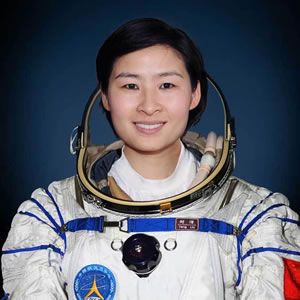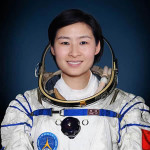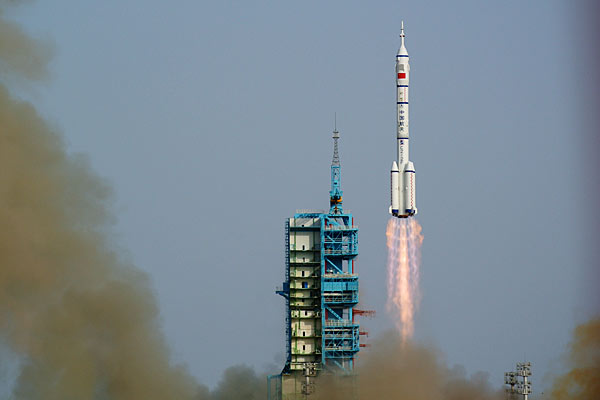

China successfully launched three astronauts into space aboard a Shenzhou-9 space capsule atop a Long March rocket to begin the nation’s most ambitious space mission to date. This launch also represents the first occasion a Chinese female astronaut has been included as part of the crew.
In the early evening hours of 16 June, the Long March rocket lifted off from China’s remote Jiuquan Satellite Launch Center located on the fringe of the northwestern Gobi Desert in what appears to be a textbook-perfect launch. Eight minutes after launch, the Shenzhou-9 capsule entered orbit and deployed its solar panels precisely on schedule.
Thirty-three year old Liu Yang, an Army pilot with more than 1,680 flight hours to her credit, became China’s first female astronaut to travel in space. Her duties during this mission are to conduct a series of medical experiments while in orbit. She joined the Chinese People’s Liberation Army (PLA) in 1997 and was recruited as a potential astronaut in 2010.
Veteran astronaut Jing Haipeng, forty-six years old and making his second space flight, is the mission commander. Jing was a member of the 2008 Shenzhou-7 mission that included China’s first spacewalk.
Rounding out the three-member crew is a space newcomer, forty-two year old Liu Wang. He is an accomplished Army fighter pilot with 14-years of experience serving with the Chinese National Space Administration’s astronaut corps.
This mission represents a critical step forward in China’s manned space program. The Shenzhou-9 is scheduled to rendezvous with the Taingong-1 (“Heavenly Palace”) space module, launched into orbit in September of last year, as a follow-on to last November’s successful Shenzhou-8 unmanned space mission. The earlier Shenzhou-8 mission successfully docked the spacecraft with the Taingong-1 space lab twice by remote control. The rousing success of the unmanned Shenzhou-8 mission convinced Chinese experts that a manned mission could be performed successfully at minimal risk of failure.
Shenzhou-9 is expected to rendezvous with the Taingong-1 space module at 1500 Beijing time on Monday. The Tiangong-1 is presently orbiting the Earth at an altitude of 213 miles. Shortly after it makes contact with the Tiangong-1 module, the Shenzhou-9 crew will attempt an automated docking to begin a 10-day long series of medical and scientific experiments during their 13-day mission. Two of the astronauts will live in the module while conducting their scheduled experiments and the third crewmember will remain aboard the Shenzhou-9 capsule to handle any emergency situations that may arise.
Should all go well, the astronauts are expected to attempt a manual dock with the module before returning home. This would involve uncoupling the Shenzhou-9 capsule, withdrawing to a pre-determined distance, and then having the crew maneuver the capsule into a successful docking operation. Liu Wang is reported to have primary responsibility for the manual docking exercise. The ability to manually dock a spacecraft with the module is critical to future Chinese space ambitions.
A second manned mission to Tiangong-1 is currently scheduled for later in the year
China has very limited experience in cooperative space activities with other nations. Due primarily to US objections, China was excluded from engaging in joint operations aboard the International Space Station (ISS). This exclusion, viewed as a humiliating snub by Chinese leaders, prompted the national leadership to begin planning a Chinese-only space lab.
The Tiangong-1 module is only a prototype of the lab China intends to build. The ultimate goal is to construct a permanently-manned station of some 60 tons featuring a 20 to 22 ton central module connected to two flanking research units. Chinese experts claim that the station would be resupplied by space freighters operating in the same manner robotic ships are employed to resupply the ISS now. The planned permanent station is tentatively scheduled for completion sometime in 2020. China’s ambitious plans largely hinge on the success of this latest mission.
Measuring a mere 10.5 meters in length and weighing in at only 60 tons, the proposed Chinese space station would be much smaller than the 400-ton ISS, but it would represent a major technological achievement for the Chinese and would advance their desires to launch a manned moon mission sometime after 2020.

China has made impressive strides in its space program in recent years. The first manned flight was launched in 2003 giving Yang Liwei the honor of being the first Chinese to orbit the Earth. The 2003 mission was followed by a two-man space flight in 2005 and a three-man excursion in 2008. During the 2008 mission, the three-man crew successfully competed China’s first spacewalk.With two satellites previously launched on moon operations and a third mission now being planned to place a rover on the moon’s surface in 2013, China has dedicated billions to its aggressive pursuit of space exploration. This is all quite a contrast to the day in 1949 when Chinese leader Mao Zedong complained bitterly that it was a sad truth that his beloved country could not even manage to launch a simple potato into space.
Despite these exceptional accomplishments, China is still trailing the United States in critical space activities like manual docking and a Chinese manned mission to the moon, to duplicate the American moon landing, is likely many years away.
Due to budget constraints and political infighting, the United States is not expected to launch another manned space vehicle until 2017 at the very earliest. With NASA’s manned operations mostly in limbo, the Obama administration has been pumping significant amounts of money into development efforts to support commercial spaceflight operations that NASA is no longer equipped to perform.

The US is currently budgeted to spend approximately $3 billion a year to fund commercial development of space vehicles capable of carrying astronauts back to the moon and to other celestial bodies of interest.With this launch, China has now become only the third nation to place a female astronaut in space using domestic technology. Events of this nature represent a key boost to China’s efforts to instill in the citizenry a heightened level of national pride and to demonstrate to the international community that China is poised to accept the role of international powerhouse.
Although the challenges facing China in its assault on space are still formidable, this latest launch brings the nation a step closer to realizing its dream to place a Chinese astronaut on the moon.
















